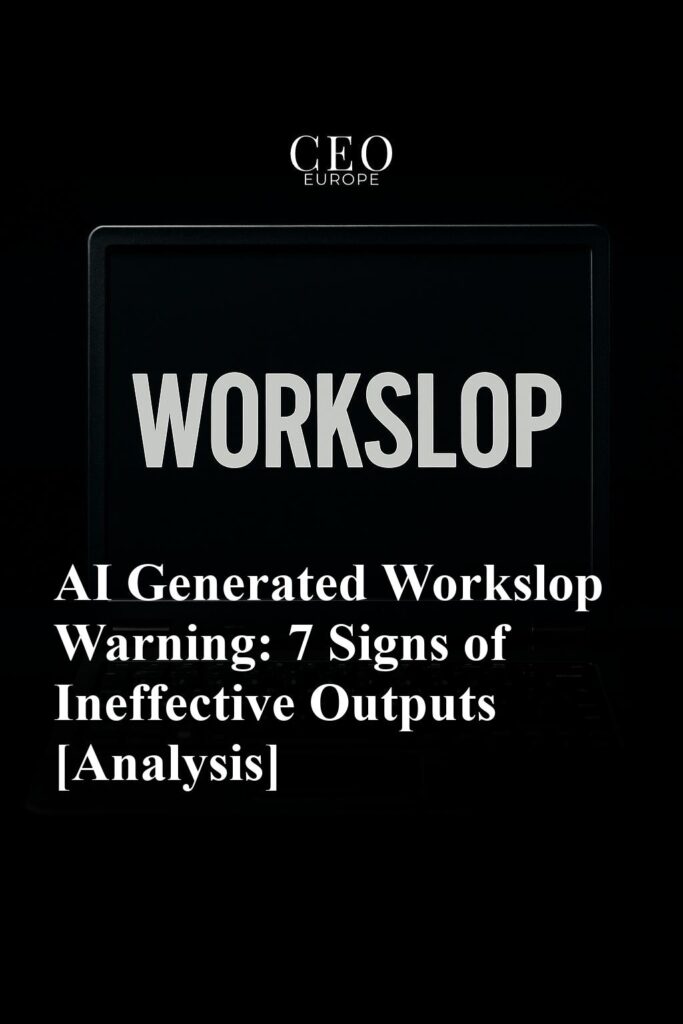1. Introduction
AI generated workslop has become a pressing concern in today’s workplaces, as organizations increasingly rely on AI to boost productivity. This term, coined by BetterUp Labs, describes low-quality AI outputs that not only fail to deliver value but actively hinder efficiency. Recognizing the signs of AI generated workslop is critical, especially as 40% of U.S.-based employees reported receiving such flawed AI-generated content within the last month [1]. These outputs often require manual correction, negating any productivity gains the AI was supposed to provide.
The rise in such low-quality AI work signals potential setbacks for teams depending on automation. Understanding these risks early can save time and resources by preventing the spread of ineffective AI assistance. As found by BetterUp Labs and their partners at the Stanford Social Media Lab, vigilance is necessary to differentiate between useful AI contributions and damaging workslop.
2. Background
AI generated workslop refers to the subpar, often incomplete or contextually inaccurate outputs produced by AI tools, which compromise productivity rather than enhance it. BetterUp Labs introduced this term to highlight the unintended consequences of hasty or indiscriminate AI deployment in teams. Like a misfired assembly line introducing defective parts, ineffective AI disrupts workflows, causing more harm than benefit.
The impact is notable: such outputs cause teams to spend extra time fixing errors or filling in missing content, creating ripple effects on morale and deadlines. Historically, AI’s adoption in business aimed to automate routine tasks, but poor oversight has led to a surge in mired productivity stemming from low-quality AI work. This evolution underscores the importance of careful AI integration strategies and ongoing quality checks.
3. Trends
Current trends reveal a paradox where AI adoption skyrockets even as AI productivity issues grow. A surprising number of organizations report difficulties leveraging AI effectively, with 95% seeing zero return on their AI investments due to poor output quality [1]. This is compounded by research from the Stanford Social Media Lab, showing how AI-generated workslop can erode trust and efficiency in teams.
The statistic that 40% of employees receive substandard AI work recently highlights urgent challenges. This situation is analogous to adopting a new tool that frequently malfunctions: rather than streamlining tasks, it becomes another burden to manage. These trends suggest a critical need for refining AI usage protocols and improving employee education on evaluating AI-generated content.
4. Insights
Analyzing AI generated workslop reveals serious operational disruptions. BetterUp Labs reports that a significant portion of organizations struggle to maintain quality control over AI outputs, leading to widespread inefficiencies [1]. For example, a marketing team relying heavily on AI for content creation encountered delays when the AI repeatedly generated vague or irrelevant drafts, forcing extensive revisions.
These case studies demonstrate how workslop negatively impacts deadlines, team cohesion, and overall output. The analogy of a leaky faucet wasting water applies here: small flaws in AI work accumulate into considerable inefficiencies. BetterUp Labs emphasizes the necessity for oversight mechanisms and ongoing evaluation to prevent AI from becoming a liability instead of an asset.
5. Forecast
Looking ahead, the challenge of AI productivity issues will persist as AI tools evolve and penetrate deeper into workplaces. However, technological improvements promise better algorithms with enhanced contextual understanding, reducing the occurrence of workslop. We can expect AI to transition from a detractor to an intelligent collaborator if organizations adopt rigorous quality control and training measures.
Predictions indicate that those who fail to address AI generated workslop risks may face increasing operational costs and employee dissatisfaction. Conversely, companies embracing best practices will gain competitive advantages as AI becomes more reliable and nuanced. Exploring the future of human-AI interactions, as in forecasts on human AI intelligence equivalence by 2025, highlights the critical balance ahead.
6. How-to
Identifying low-quality AI work involves spotting missing context, repetitive errors, and outputs that require disproportionate human intervention. Teams should routinely review AI outputs with clear quality benchmarks, encouraging feedback loops to improve AI training datasets.
To mitigate AI generated workslop, organizations can:
– Implement AI usage guidelines emphasizing accuracy and relevance.
– Invest in AI literacy programs for employees.
– Leverage AI management tools that flag potential low-quality outputs before they reach stakeholders.
For instance, integrating workflow tools that automatically verify AI-generated content can save enormous time. By following these best practices, teams reduce risk and enhance the overall reliability of their AI outputs.
7. FAQ
Q: How can I tell if AI work is truly low quality or just different?
A: Look for lack of contextual relevance, excessive generic content, or outputs that frequently require manual corrections—they are signs of AI generated workslop.
Q: Can AI productivity issues be fully eliminated?
A: Complete elimination is unlikely, but careful oversight and continued AI model improvement can significantly reduce poor outputs.
Q: Is all AI-generated workslop due to faulty AI?
A: Not necessarily. Workslop can also stem from improper training data, inadequate prompts, or unrealistic expectations of AI capabilities.
Addressing misconceptions about AI’s role is essential to harness its power without falling victim to its pitfalls.
8. Conclusion
In conclusion, the risks associated with AI generated workslop cannot be ignored. Vigilance in identifying and addressing these low-quality AI outputs is essential to safeguard productivity and maintain team morale. Employing robust best practices, such as establishing quality controls and training users effectively, is critical to overcoming AI productivity issues.
As AI continues to evolve, its integration into workplaces holds great promise—provided we remain cautious and proactive. Only through intelligent, mindful use of AI can organizations truly unlock its potential without succumbing to the productivity drain posed by workslop.
Sources and references
1. Beware Coworkers Who Produce AI-Generated Workslop – TechCrunch

